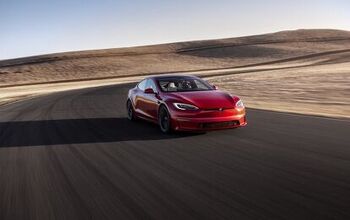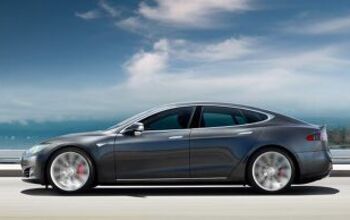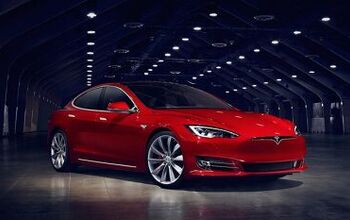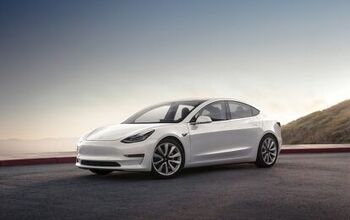Tesla Adding Track Mode to Model S Plaid

While it’s possible to catch a glimpse of a Tesla Model S staging at the local dragstrip, they don’t make many appearances at track days. EVs that weren’t designed specifically for racing circuits typically become undone after a few laps of sustained abuse, with Tesla’s first sedan being no different. Early examples of the Model S even failed to get around the Nürburgring when pushed to the limit, with touring car driver Robb Holland sharing videos of the model forcing itself into limp mode as components began overheating during a test run in 2014. Holland praised the car for its sublime road manners, though concluded it was ill-suited for serious racing.
Things are a little different today. Tesla now holds the fastest single lap of any EV to grace the Nordschleife and sells the Model 3 Performance with a dedicated track mode it plans on extending to Model S Plaid vehicles via an over-the-air (OTA) update. But can some fresh code and a little time really do what’s required to make the sedan a valid track vehicle when the preexisting hardware remains unchanged?
The big get with Tesla’s track mode is the ability to tweak or (allegedly) defeat the sedan’s fairly invasive stability control system. Handy during the daily commute, stability control ultimately limits what the car could do on a pristine racetrack. On the Model 3, this results in putting regenerative braking into overdrive and using it to assist with torque vectoring. Though the driver is never really free from getting assistance since the automaker’s vehicle dynamics controller is constantly monitoring things to decide how best to divert power to improve rotation.
However, the biggest gripe among those attempting to race the Model S typically stems from the heat management program erring on the side of caution. This too has been addressed with track mode by offering the same pre-cooling system that’s on the Model 3. Here, Tesla lowers the operating temperature of the battery pack in preparation for the onslaught of heat it’s about to be subjected to. It does the same whenever the car has pulled off the track or is enjoying a cooldown lap. The manufacturer claims the system allows for operation of the powertrain beyond typical thermal limits and increases refrigerant system capacity by overclocking the AC compressor into higher speed ranges.
The rest is about what you’d expect from any track mode. Dampers default to their setting and the infotainment system swaps to displaying all the relevant temperature readings, with a lap timer and G-meter thrown in for good measure.
Unfortunately, I’ve still not seen many Model 3 Performances make more than a handful of laps on any course before it begins issuing warnings about the brakes or battery overheating. But overheating is a common concern among people tracking their street cars and it’s probably not fair to directly compare a Tesla luxury product to something that’s been equipped with an external oil cooler and some tow hooks.
Tesla said this is all about keeping the fastest EV lap time at the Nürburgring and prepping the Model S for a 200-mph top speed that’s supposed to come by way of future OTA updates. I’m inclined to believe this will require a few hardware updates to be accomplished safely, however. As nice as the Model S is to take on the freeway, its steering needs to be sharpened before the company decides to transform it into a four-door hypercar. It’s also going to need better tires and brakes — the latter of which Tesla plans on offering by way of a carbon-ceramic brake kit for $20,000 available later this year. Though they’ll technically cost more than that since you’ll also have to purchase the 21-inch wheels in which to house your fancy stoppers.
With the ability to breeze past 60 mph in the low two-second range, nobody paying attention is going to claim the Model S Plaid isn’t an extremely fast car. But it seems to do all its best work in a straight line and I’m not sure why the manufacturer is so obsessed with competing with Porsche on the Nürburgring. These planned updates will undoubtedly make it more capable from a performance perspective, I just have doubts that it’ll make for a better luxury sedan or set the Model S to replace the Mazda MX-5 as the default track day automobile.
[Image: Virrage Images/Shutterstock]

A staunch consumer advocate tracking industry trends and regulation. Before joining TTAC, Matt spent a decade working for marketing and research firms based in NYC. Clients included several of the world’s largest automakers, global tire brands, and aftermarket part suppliers. Dissatisfied with the corporate world and resentful of having to wear suits everyday, he pivoted to writing about cars. Since then, that man has become an ardent supporter of the right-to-repair movement, been interviewed on the auto industry by national radio broadcasts, driven more rental cars than anyone ever should, participated in amateur rallying events, and received the requisite minimum training as sanctioned by the SCCA. Handy with a wrench, Matt grew up surrounded by Detroit auto workers and managed to get a pizza delivery job before he was legally eligible. He later found himself driving box trucks through Manhattan, guaranteeing future sympathy for actual truckers. He continues to conduct research pertaining to the automotive sector as an independent contractor and has since moved back to his native Michigan, closer to where the cars are born. A contrarian, Matt claims to prefer understeer — stating that front and all-wheel drive vehicles cater best to his driving style.
More by Matt Posky
Latest Car Reviews
Read moreLatest Product Reviews
Read moreRecent Comments
- Probert They already have hybrids, but these won't ever be them as they are built on the modular E-GMP skateboard.
- Justin You guys still looking for that sportbak? I just saw one on the Facebook marketplace in Arizona
- 28-Cars-Later I cannot remember what happens now, but there are whiteblocks in this period which develop a "tick" like sound which indicates they are toast (maybe head gasket?). Ten or so years ago I looked at an '03 or '04 S60 (I forget why) and I brought my Volvo indy along to tell me if it was worth my time - it ticked and that's when I learned this. This XC90 is probably worth about $300 as it sits, not kidding, and it will cost you conservatively $2500 for an engine swap (all the ones I see on car-part.com have north of 130K miles starting at $1,100 and that's not including freight to a shop, shop labor, other internals to do such as timing belt while engine out etc).
- 28-Cars-Later Ford reported it lost $132,000 for each of its 10,000 electric vehicles sold in the first quarter of 2024, according to CNN. The sales were down 20 percent from the first quarter of 2023 and would “drag down earnings for the company overall.”The losses include “hundreds of millions being spent on research and development of the next generation of EVs for Ford. Those investments are years away from paying off.” [if they ever are recouped] Ford is the only major carmaker breaking out EV numbers by themselves. But other marques likely suffer similar losses. https://www.zerohedge.com/political/fords-120000-loss-vehicle-shows-california-ev-goals-are-impossible Given these facts, how did Tesla ever produce anything in volume let alone profit?
- AZFelix Let's forego all of this dilly-dallying with autonomous cars and cut right to the chase and the only real solution.


































Comments
Join the conversation
The super-fast Teslas just don't seem relevant to daily life. I've test-driven both my friend's Model 3 Performance and a demo dual-motor Model 3 Long Range Plus (the car now sold as just plain Long Range). In default settings, the Long Range Plus was the nicer car to drive, because the Performance's throttle was a hair trigger. The Long Range Plus was more than quick enough for any street driving situation. The Performance trim seems to me like a way to get bragging rights while making your car worse, unless you take it to a drag strip. Of course all this is even more extreme when you compare the regular and Plaid versions of the Model S.
the reviews I watched of the Plaid all said it was badly under braked. Hopefully this is being addressed.